A 2005 media event promised more affordability than what’s been produced. The next mayor may face tough decisions, as 876 more income-linked units must be built in four years.
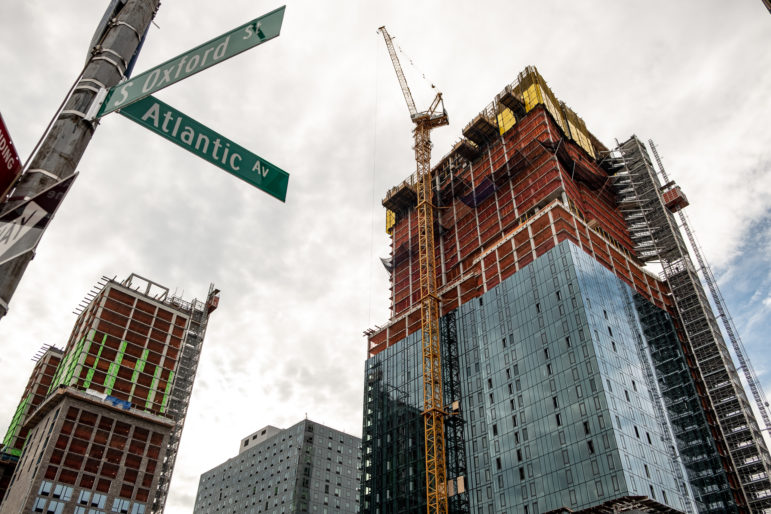
Adi Talwar
Construction underway in November at the Atlantic Yards/Pacficic Park development in Brooklyn.Trailing badly in the polls, Democratic mayoral candidate Shaun Donovan doesn’t seem like a serious contender.
But Donovan, who headed housing departments for both New York City under Mayor Mike Bloomberg and the federal government under President Barack Obama, has serious policy chops, proposing an extensive housing policy, aiming to increase “the supply of affordable housing, equitably and inclusively, across all five boroughs.”
So it’s disappointing to see Donovan unwisely touting the Atlantic Yards project announced under Bloomberg as an exemplary public-private partnership. In a Real Deal interview Feb. 3, he said the next mayor should plan for “equitable growth.”
“You folks may remember that when we announced Atlantic Yards and the thousands and thousands of units of affordable housing it would create, Bertha Lewis, the legendary progressive activist from ACORN, kissed Mike Bloomberg on the lips,” Donovan stated. “Those are the kind of partnerships that I could build, bringing together progressive leaders and the public sector, the private sector, to create growth.”
In a talk with the Association for a Better New York, Donovan said “we reached a landmark agreement”—actually, the city highlighted a non-binding private deal—to build Atlantic Yards.
Why it matters
It’s too bad that Donovan, whose substantial ideas on housing deserve discussion, gets this wrong—and it’s likely most of his rivals know even less about the issue. But the details matter, just as it matters that candidates know how much Brooklyn real estate costs.
Atlantic Yards was a dubious triumph as of that 2005 “kiss” and today remains a cautionary tale, given the huge gaps between promises and production at the project now known as Pacific Park Brooklyn.
That’s relevant to not just Donovan but also his better-polling rivals, since the next mayor will face tough decisions regarding whether to subsidize—and otherwise further—the yet-unfinished project.
Of the required 2,250 affordable apartments, 782 have been completed and 592 are currently under construction. So 876 income-targeted units face a time crunch. For each affordable unit not ready by May 31, 2025, the developer—now mainly Greenland USA, the arm of a Shanghai-based conglomerate—faces an onerous $2,000/month in state penalties.
So the next mayor could help determine whether those apartments serve the struggling lower-income New Yorkers who Lewis championed, or the middle-income residents who’ve received a disproportionate share of the project’s affordable housing.
That new administration also could continue to greenlight after-hours variances—consistently under-disclosed by the developer—that have helped the project meet its deadlines, allowing work to take place from 5 to 10 a.m. weekdays and on both weekend days, all while neighbors are stuck at home.
Flashback to the Bloomberg era
Atlantic Yards was announced in December 2003 at a press conference featuring Mayor Bloomberg, Brooklyn Borough President Marty Markowitz, and developer Bruce Ratner, whose company Forest City Ratner aimed to move the New Jersey Nets to Brooklyn and build an arena plus 16 towers, all designed—as of then—by “starchitect” Frank Gehry.
A huge civic fight ensued. ACORN’s role came later, as Forest City organized its own “community” coalition, countering criticism of a project relying on a bypass of City Council, eminent domain, and a suite of subsidies and tax breaks.
Forest City negotiated with Lewis and ACORN housing specialist Ismene Speliotis to devise the “50/50 plan,” which deemed half of the 4,500 rental apartments be affordable, with five tiered income levels. That would set a benchmark for gentrifying Brooklyn, Lewis argued—albeit thanks to what was the equivalent of a one-off upzoning.
But the press conference on May 19, 2005 that Donovan now recalls, unveiling the project’s Affordable Housing Memorandum of Understanding (MOU), deserved more skepticism than it got. First, the agreement involved Forest City and ACORN, not public entities.
A city press release misleadingly said 2,250 apartments, half of the rental units, would go to “low- and moderate-income households.” That ignored how, among those 2,250 affordable units, 40 percent—two of the five tiers—were for middle-income households.
The press release, dubiously implying certainty, stated that the administration “worked with Forest City Ratner and ACORN to increase the amount of financing provided to make the apartments as affordable as possible.” But no financing had been allotted, because the project hadn’t been approved. (The first residential tower wouldn’t launch until December 2012.)
Still, the event was dramatic. “I’m getting ready to pay my debt, and here it is!” Lewis declared, kissing the reluctant mayor on the lips, their mouths firmly closed, as captured in a Brooklyn Paper photo.
That housing plan was incorporated into the much-hyped Atlantic Yards Community Benefits Agreement (CBA), a private contract Forest City signed with ACORN and seven other groups—most of which were essentially astroturf—which purported to ensure the touted benefits came to pass.
 CityViews are readers’ opinions, not those of City Limits. Add your voice today!
CityViews are readers’ opinions, not those of City Limits. Add your voice today!
But the Housing MOU was non-binding and the CBA proved unenforceable; Forest City never hired the required Independent Compliance Monitor, and the only parties with any standing to intervene—the signatories—were dependent on the developer.
Changing the game
Atlantic Yards gained approvals in December 2006 from New York State, which oversees the project, but lawsuits and the recession caused delays. So in 2009, Forest City wrangled better terms with state agencies.
On top of that, the project’s binding Development Agreement defined affordable housing broadly, simply requiring participation in a government program. So much for the Housing MOU’s goals of income tiering and of allotting half the floor area to family-sized units.
So the project’s initial tower—the sole “50/50” one, so far—not only omitted three-bedroom apartments, but the two-bedroom affordable units it did include were skewed to middle-income households, as 16 would rent for more than $3,000 per month (as of 2016), and only 10 below $1,000.
As Forest City’s ambitious gambit to build the entire project via cost-saving modular construction failed, the company announced it would sell a majority share—at a loss—to Greenland, creating Greenland Forest City Partners.
With approval of that sale pending in 2014, local activists in the coalition BrooklynSpeaks saw an opening on affordable housing. After threatening a fair-housing lawsuit—on the grounds that Black Brooklynites would be displaced before they could gain community preference in a housing lottery—BrooklynSpeaks got the state to impose that 2025 housing deadline.
While that significantly improved on the generous 2035 “outside date” in state contracts—a 25-year buildout—it was well behind the 10-year timeline long asserted.
As part of that settlement, the developer agreed to build two “100 percent affordable” buildings, which Mayor de Blasio, then a Lewis ally, touted as a bargain for the city. But de Blasio was stressing unit count, not affordability.
Fully half those apartments were designated for the middle-income “band” that, according to Lewis’s original plan, should’ve represented one-fifth of the units. ACORN housing expert Speliotis, who now oversees Pacific Park affordable housing intake as head of the Mutual Housing Association of New York, acknowledged that middle-income units were “a harder band to fill.”
Indeed, after the city’s housing lottery failed to deliver middle-income tenants, such units were listed on StreetEasy, provoking a scornful headline in the New York Times. Perhaps that’s part of why Lewis ally Jonathan Westin, of ACORN successor New York Communities for Change, would decry “City Hall’s focus on building a fake 300k [affordable] units.”
In other words, the “alliance” Donovan invokes seems to have frayed. Nor has the project produced affordable condos, despite the announced 2005 aspiration for 600 to 1000 such units, on or off-site. The 225 projected apartments for seniors? Absent.
Changing constraints, changing plans
As city and state housing plans have changed, so too has Pacific Park. Today four towers are under construction, promising 30 percent affordable units, keyed to the Affordable New York tax break, the successor to 421-a.
The developer has refused to disclose the expected affordability level, but the lender for the largest tower stated that all 258 affordable units would go to middle-income households, at 130 percent of Area Median Income (AMI), which translates into one-bedrooms renting for $2,838 (The developer claimed that nothing has been set.) No wonder the de Blasio administration aims to restrict that affordability level configuration, known as Option C.
To complete the additional 876 Pacific Park affordable units in four years (the rest of the project has until 2035), developer Greenland Forest City faces twin unknowns: the availability of discretionary subsidies/tax breaks, and the city’s post-pandemic future.
To meet that 2005 vision of Atlantic Yards—ensuring more low- and moderate-income apartments—a future mayor might have to devote extra subsidies for the project. (Under the expiring Affordable New York, which may be revised, renewed, or ended, the developer could still build units at 130 percent of AMI, at least if construction starts by June 15, 2022.)
Indeed, candidate Donovan aims to “create a new mixed-income model that includes deeply affordable units.”
Should that apply to those remaining Pacific Park apartments? Donovan’s housing platform offers some intriguing guidance for future mayors, proposing “a sliding scale for public financial support—by way of subsidy, tax abatement or exemption, land, or other methods—that matches the amount of support to the amount of affordable housing being produced.”
An examination of Atlantic Yards/Pacific Park, for example, might assess a dubious tax break that delivered no new affordable units but saved wealthy condo buyers millions, bolstering the developer’s high sticker prices. Or, perhaps, the state approval of new below-grade space for a fitness center and fieldhouse, with no reciprocal public benefit.
Atlantic Yards can’t be reduced to a snapshot in Bloomberg time, but rather raises issues of oversight, transparency, and contract negotiations—which apply to other development disputes, too.
In an October 2013 profile before his crucial victory, de Blasio pledged, regarding Atlantic Yards, to hold the developer and the state accountable and that, “On my watch, [the housing] will happen.” Not quite, so the issue still looms.
Brooklyn journalist Norman Oder writes the Atlantic Yards/Pacific Park Report blog and is working on a book about the project.
Shaun Donovan responds:
The recent op-ed piece authored by Norman Oder gives a very narrow assessment of the Atlantic Navy Yard’s shortcomings and successes.
First and foremost, creating aggressively affordable housing anywhere in New York City is challenging. I know because I have 30+ years of experience building affordable housing in this city and around the country. During my tenure as NYC Housing Commissioner, I created what was at the time the most aggressive affordable housing plan in the nation to create 165,000 units over 10 years in New York City.
I also led a first-of-its-kind international design competition called New Housing New York that led to the development of Via Verde, a true model for what green, healthy, thoughtful affordable housing looks like.
That said, I know how hard it is to build units for very low income households and that is why my current housing plan allocates serious resources to not only create more housing but to substantially increase funding for housing vouchers. We definitely need to build more housing, but we also need to provide people with the rental assistance they need right now.
I also support the principle of building mixed income, mixed use developments near transit hubs in higher income areas. It is essential for climate goals and a critical part of my 15-minute neighborhoods plan. Additionally, it can’t be that we only build new affordable housing in low-income neighborhoods–every neighborhood in NYC must do its fair share to ensure that more New Yorkers can afford to live where they choose.
More importantly, if we are going to build the amount of affordable housing our city needs and deserves, we are absolutely going to need to partner with the private sector and suggesting otherwise is woefully naive. The Atlantic Yards project serves as an example of what is possible through private-public partnership, and will add a large number of affordable housing units to Clinton Hill/Prospect Heights. The developers are legally committed to building 2,250 affordable housing units.
At the same time, there is always room for improvement, and this project provides the opportunity to learn how to design and build better enforcement mechanisms to ensure that developers build units large enough to accommodate lower income families. As Mayor, I will use my deep experience creating affordable housing here in New York City and across the country to make sure that every New Yorker, regardless of their zip code, can live a life of dignity in the home of their choosing.


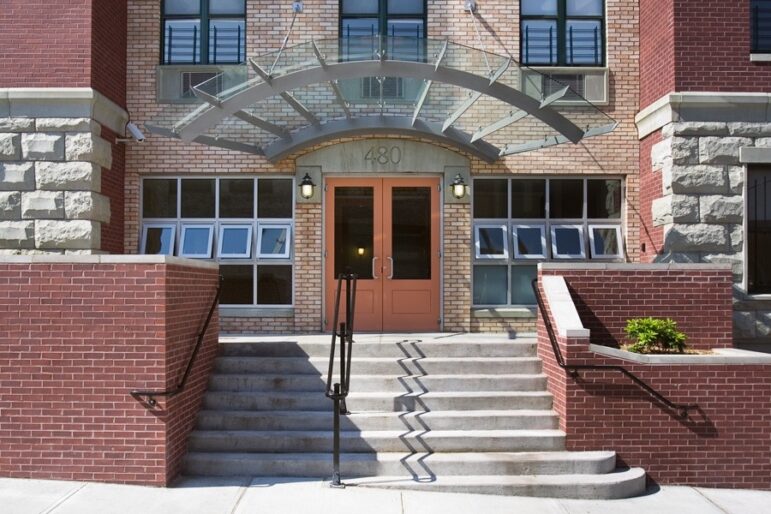

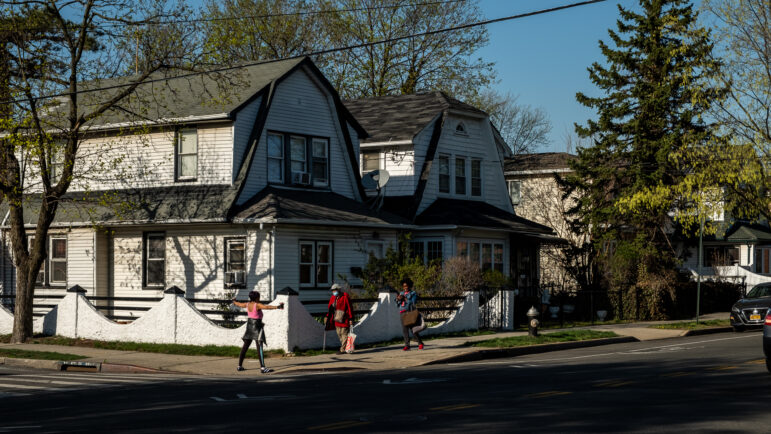
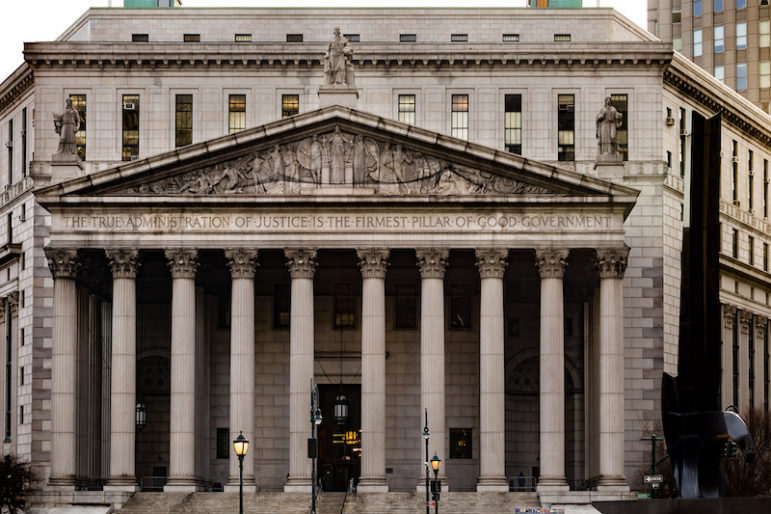
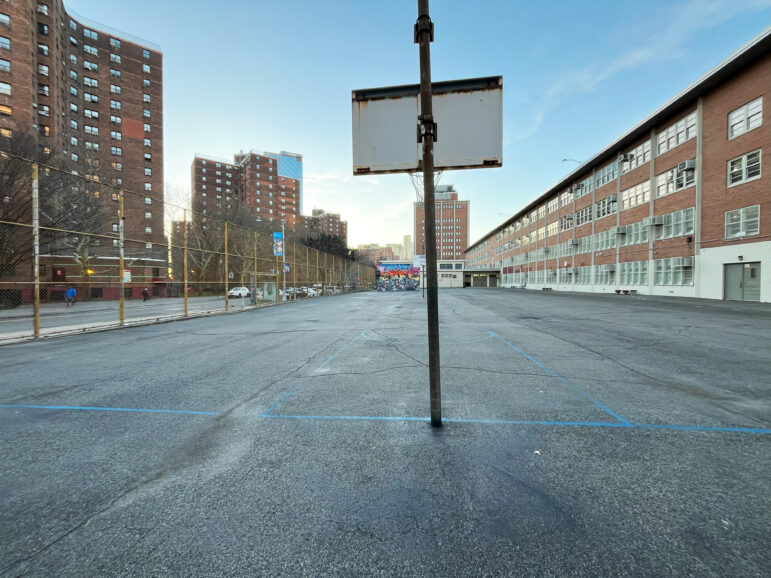


One thought on “Opinion: Shaun Donovan Praises Atlantic Yards, But It’s No Model Housing Partnership”
“Atlantic Navy Yard”? Atlantic Yards apartments in Clinton Hill? As a candidate for Mayor, one would expect Mr. Donovan to know at least the name and location of the largest development project in Brooklyn. As an authority on housing policy, he ought to explain how to fix a project that has been bailed out at least twice already so it finally delivers what was originally promised the public in 2006.